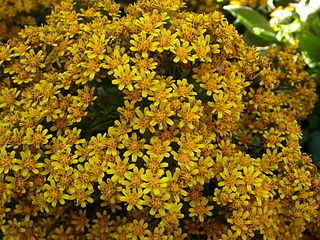
Senecioneae is the largest tribe of the Asteraceae, or the sunflower family, comprising over 150 genera and over 3,500 species. Almost one-third of the species in this tribe are placed in the genus Senecio. Its members exhibit probably the widest possible range of form to be found in the entire plant kingdom, and include annuals, minute creeping alpines, herbaceous and evergreen perennials, shrubs, climbers, succulents, trees, and semi-aquatic plants.

Othonna is a genus of approximately 90 species of succulent or subsucculent perennial herbs or shrubs, with its center of diversity in the Greater Cape Floristic Region (GCFR) of South Africa but some species' ranges include southern Namibia, Angola, and Zimbabwe. The genus was established by Linnaeus in 1753 containing 14 species, however, of those original species, only four are still retained in Othonna, while the others have been transferred to different genera including Cineraria, Euryops, Hertia, Ligularia, Senecio, and Tephroseris. The genus Othonnna is known to be monophyletic. In 2012, a new genus Crassothonna B. Nord. was erected with 13 species transferred from Othonna. A complete modern taxonomic treatment of the genus is being undertaken by the Compton Herbarium and the South African National Biodiversity Institute. The first part, a revision of the Othonnna bulbosa group, was published in 2019.
Crassothonna clavifolia is a species of flowering plant in the family Asteraceae. It is found only in Namibia. Its natural habitat is rocky areas. It is threatened by habitat loss.

Rune Bertil Nordenstam is a Swedish botanist and professor emeritus at the Swedish Museum of Natural History in the Department of Phanerogamic Botany. He has worked with Colchicaceae, Senecioneae and Calenduleae, was the editor of Compositae Newsletter newsletter since 1990, and is a Tribal Coordinator for The International Compositae Alliance with responsibility for the tribes Calenduleae and Senecioneae.
Antillanthus is a genus of the tribe Senecioneae in the family Asteraceae described as a genus in 2006. Many members of this genus were previously listed as Pentacalia and Senecio.

Acrisione is a genus of the tribe Senecioneae of the family Asteraceae, native to Chile and southern Argentina. It was first described as a genus in 1985.

Elekmania is a genus of the tribe Senecioneae and the family Asteraceae.

Pieter B. Pelser is a lecturer in Plant Systematics and the curator of the herbarium at the University of Canterbury in Christchurch, New Zealand. One research interest is the evolutionary history of the tribe Senecioneae, one of the largest tribes in the largest family of flowering plants. He wrote the most recent attempt to define and delimit this tribe and its problematic founding species Senecio. He also studies insects that eat these plants (Longitarsus) which contain pyrrolizidine alkaloids and what makes them choose which plants they eat.
Anderbergia is a genus of flowering plants in the family Asteraceae described as a genus in 1996.
Caucasalia is a genus of flowering plants in the daisy family.

Dolichoglottis is a genus of flowering plants in the daisy family, Asteraceae.

Nemosenecio is a genus of East Asian flowering plants in the groundsel tribe within the sunflower family.

Phaneroglossa is a genus of plants that is assigned to the daisy family. It consists of only one species, Phaneroglossa bolusii, a perennial plant of up to 40 cm high, that has leathery, line- to lance-shaped, seated leaves with mostly few shallow teeth and flower heads set individually on top of long stalks. The flower head has an involucre of just one whorl of bracts, few elliptic, white or cream ray florets, and many yellow disc florets. It is an endemic species of the Western Cape province of South Africa. Flowering mainly occurs from November to January.
Sinosenecio, also butterweed, is a genus of Asian plants in the groundsel tribe within the daisy family. Most of the species are found only in China, with a few extending southward into Indochina.
Hilliardia is a monotypic genus of South African flowering plants in the daisy family. It only contains one known species, Hilliardia zuurbergensis(Oliv.) B.Nord.
Leucoptera is a small genus of flowering plants in chamomile tribe within the daisy family.
Odontocline is a genus of Jamaican flowering plants in the daisy family.
Cymbopappus is a genus of flowering plants in the daisy family. The genus is endemic to South Africa.
Nesampelos is a genus of flowering plants in the daisy family, native to the Island of Hispaniola in the West Indies.

Caputia is a small genus of flowering plants in the family Asteraceae, native to South Africa. It may be of hybrid origin. Species in this genus were formerly considered part of the genus Senecio.









